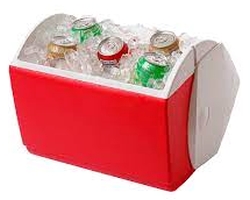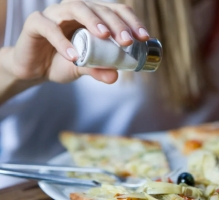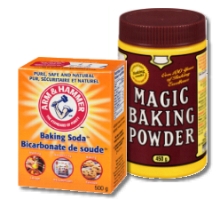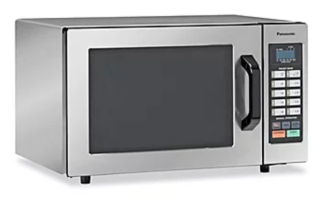 "As a master chef and a superior cook, there are quite a few secrets I could share with you". I've always wanted to say that. Actually I'm lucky if I can make toast without burning it. Recipes I've tried seldom turn out like they're supposed to, usually because I make strange substitutions, or don't follow directions. I suspect this was also the reason why I never did well in Chemistry, at least in the lab. See my story 'My Fling with Chemistry'. However, I do love to learn, especially with regard to anything science related, and over the years I've come across some fascinating bits of chemistry information that apply to cooking. I'm sharing some of them here. Smelly Fish  You may have noticed that fish smells a lot worse than chicken when it's been in your fridge a little too long. Part of the reason is because the cold temperatures in your fridge do a good job of slowing the chemical reactions happening in warm-blooded animal flesh like chicken and beef, but not so much in fish, whose natural environment was cold water.
You may have noticed that fish smells a lot worse than chicken when it's been in your fridge a little too long. Part of the reason is because the cold temperatures in your fridge do a good job of slowing the chemical reactions happening in warm-blooded animal flesh like chicken and beef, but not so much in fish, whose natural environment was cold water. Fish flesh also contains high levels of a chemical that breaks down into trimethylamine, which smells like ammonia in high concentrations. If your fish smells just a little fishy after a few days, you may not need to throw it out. Just soak the fish in milk for about half an hour. The casein in the milk will combine with those smelly compounds and draw them out of the flesh. Of course, if enough time passes, nothing can save spoiled food. Especially if it hasn't been refrigerated. I have some unfortunate first-hand experience with this. We were cleaning the porch one day at the end of June, getting ready to leave to visit family in Ontario for the summer. One of us accidently knocked the plug for the freezer loose from the wall without noticing. When we returned almost two months later and opened the freezer, the smell was like nothing we'd ever experienced. Completely overpowering. Needing to deal with all the spoiled and rotten food meant we had to remove everything from the freezer. I couldn't get close without gagging. I tried the trick of putting Vicks Vapo-Rub under my nose like they do on TV ... didn't do a thing! Jane was able to get close enough to reach in, by holding her nose, and she passed me items that I bagged. A frozen turkey was a bag of liquid with a few bones in it. Steaks and chicken were puddles of liquid on the bottom, floating in liquids that weren't recognizable. Somehow we got the freezer empty, and with help from a friend, managed to drag it outside and hose it out. No amount of hosing and applications of baking soda and lemon cleaners would remove the smell. Our porch fared better; with much cleaning and spraying, in a week the smell was gone. Brown Fruit  You can keep fruit from browning by spraying a little lemon juice on it. Fruit like apples gets brown when an enzyme in the fruit, called polyphenol oxidase, is exposed to oxygen in the air. A chemical reaction called oxidation ('combining with oxygen') turns compounds in the fruit into melanin. (This is the same melanin that makes your skin turn brown when you tan or freckle). The vitamin C and citric acid that's in lemon juice slows chemical reactions, so the fruit browns more slowly.
You can keep fruit from browning by spraying a little lemon juice on it. Fruit like apples gets brown when an enzyme in the fruit, called polyphenol oxidase, is exposed to oxygen in the air. A chemical reaction called oxidation ('combining with oxygen') turns compounds in the fruit into melanin. (This is the same melanin that makes your skin turn brown when you tan or freckle). The vitamin C and citric acid that's in lemon juice slows chemical reactions, so the fruit browns more slowly.
Cooling Drinks Quickly  You have friends over, and want to cool your bottled or canned drinks quickly. Put the drinks in a cooler with water and lots of ice, and add a whole bunch of salt! Salt added to the water lowers the temperature at which the water freezes, and since water can surround the bottles and cans better than ice cubes can, cold liquid salt water is what you want. The salty ice-water mixture will be much colder than ice on its own, which means it can give you cold drinks in about five minutes! Just have a cloth handy to wipe down the cans as people remove them.
You have friends over, and want to cool your bottled or canned drinks quickly. Put the drinks in a cooler with water and lots of ice, and add a whole bunch of salt! Salt added to the water lowers the temperature at which the water freezes, and since water can surround the bottles and cans better than ice cubes can, cold liquid salt water is what you want. The salty ice-water mixture will be much colder than ice on its own, which means it can give you cold drinks in about five minutes! Just have a cloth handy to wipe down the cans as people remove them.
Salting Your Food  Lots of people add salt to their food immediately after it's been served, without even tasting it. This is a bad idea for two reasons.
Lots of people add salt to their food immediately after it's been served, without even tasting it. This is a bad idea for two reasons. First, almost all foods have salt in them already. Too much salt (sodium chloride) is bad for you; too much sodium in the diet can lead to high blood pressure, heart disease, and stroke. It can also cause calcium losses, weakening your bones. Most North Americans consume at least 1.5 teaspoons of salt per day, or about 3400 mg of sodium, which contains far more than our bodies need. The second reason is quite interesting. The temperature of our food affects how we perceive flavour. The hotter the food is, the less salty it tastes. After the food on your plate has cooled for a few minutes, you'll be able to gauge with your tongue the true saltiness of the dish, and can add salt if needed. (Incidentally, cold temperatures make foods seem less sweet! Think about that one!) Baking Soda and Baking Powder 
Both baking soda and baking powder are used in cooking. What do they do, and what's the difference? Baking soda is 100% sodium bicarbonate (NaHCO3), an alkaline salt compound that creates carbon dioxide gas when mixed with an acid. Baking powder is a mixture of sodium bicarbonate and an acid like cream of tartar, which requires moisture and heat to activate. Baking soda needs to mix with acid to create carbon dioxide (which is used to make foods you cook expand), so you will often find it in recipes containing an acidic ingredient like cocoa powder or buttermilk. The baking soda and acid combine to give off CO2. That's what happening inside batter, for example, to make cookie dough expand. Baking soda also promotes browning, and will keep green vegetables greener when boiled. Baking powder already has an acid in it, so it's used in recipes where an acid is not already a significant ingredient, in order to create CO2 bubbles that give your baked goods a light, airy texture. You will see it in vanilla cake recipes, for instance, which use regular milk for moisture and the heat of the oven to activate the baking powder. While they're usually associated with cookies and muffins, both baking soda and baking powder are also useful in other dishes. Coating the skin of a turkey in a mix of baking powder and large-grained salt will result in crisper, more evenly browning. This is because the baking powder raises the skin's pH, making it more basic (less acidic) to help break down the proteins in the skin, while also forming bubbles that increase the surface area while it cooks, for a crunchy texture. Baking soda also raises the pH of meat to break down proteins and keep it tender, but has a more metallic taste than baking powder, so it works better if you soak the meat in it first, and rinse. Baking soda is also a well-established way to remove pesticides from your fruit. You don't need to buy a special spray; just make a solution of baking soda and water. Recipes Needing Uncooked Eggs  Sometimes recipes call for uncooked eggs. Mayonnaise, egg nog, and salad dressing are some examples. Sometimes you might be tempted to eat a large spoonful of raw cookie dough.
Sometimes recipes call for uncooked eggs. Mayonnaise, egg nog, and salad dressing are some examples. Sometimes you might be tempted to eat a large spoonful of raw cookie dough.But we all know that you're supposed to cook eggs before eating them, because there's a risk of contracting illnesses from bacteria like salmonella. How do you avoid this risk? You can reduce the risk by pasteurizing the eggs first! This just means heating them enough to kill any bacteria, without actually cooking the eggs. You'll need a cooking thermometer so that you can heat the eggs in water heated to about 141 degrees Fahrenheit (61 degrees Celsius), for three to five minutes. Rinse them immediately in cold water. The relatively low water temperature will be enough to kill bacteria, but not hot enough to cook the eggs themselves. Microwave cooking  Microwave ovens heat food using microwaves, a form of electromagnetic radiation similar to radio waves. Microwaves do the job because they are reflected by metal; they pass through glass, paper and plastic; and they are absorbed by most foods.
Microwave ovens heat food using microwaves, a form of electromagnetic radiation similar to radio waves. Microwaves do the job because they are reflected by metal; they pass through glass, paper and plastic; and they are absorbed by most foods.A device called a magnetron inside the oven produces microwaves, which reflect off the metal interior and cause water molecules in food to vibrate. This vibration results in friction between molecules, which produces the heat that cooks the food. Microwaves are non-ionizing radiation, which means that they don't strip electrons from the atoms in living tissue, so they aren't dangerous like x-rays. Nevertheless, microwave radiation can heat body tissues the same way it heats food. Microwave energy will not leak from a microwave that's in good condition. Foods that are high in water content, like fresh vegetables, can be cooked more quickly than other foods. The microwave energy is changed to heat as it is absorbed by food, and does not make food 'radioactive' or 'contaminated'. Microwave cooking is more energy efficient than conventional cooking not only because foods cook faster, but also because the energy heats only the food, not the whole oven compartment. Microwave cooking doesn't reduce the nutritional value of foods any more than conventional cooking; rather, foods cooked in a microwave often keep more of their vitamins and minerals because they aren't being boiled in water. Microwave ovens don't cook food from the 'inside out'. When foods are cooked, the outer layers are heated and cooked mostly by microwaves, while the inside is cooked mainly by the conduction of heat from the hot outer layers. This means that you can cut up larger foods to speed up cooking time. You can also stir soft foods at least once to facilitate the spread of heat within. Microwaved food will continue to cook for a minute or so after the machine is turned off, so you should let the food stand for a minute for the molecules to finish bouncing round. Containers can become hot from the heat of the food cooking inside. Some plastic containers shouldn't be used because they can melt. Here are some other things you should never put into a microwave oven: Styrofoam isn't just bad for the environment, it also melts quickly. Like plastic, this can release dangerous chemicals into your food and potentially cause long term illnesses. Plastic bags and containers like yogurt tubs should never be microwaved because they may melt, and they contain bisphenol A (BPA) which could be released into your and has been linked to a variety of health issues. Microwaving an egg in its shell is dangerous and messy. The rapid heating creates steam inside the egg, which can cause it to explode. Very messily! Microwaving broccoli can destroy its goodness. Steaming them instead preserves the colour and the nutrients. Tomato-based pasta sauce if cooked uncovered will splatter all over the inside of the microwave appliance because the thickness traps steam until it escapes violently. There is also danger in heating water by itself in a clean cup, perhaps for instant coffee or tea, in that it may explode! This is a real thing! It gets superheated, and when you take it out of the microwave, if you jar it, or add instant coffee, it may suddenly erupt violently out of the cup and burn you. See ouur page about microwave boilovers. Safe things you can do with your microwave (besides cooking a meal): |